 |
| |
MI6 trawls the archives to see how critics received Timothy Dalton's debut outing 007 in "The Living Daylights"...
|
|
Time Tunnel: Review Rewind
16th October 2010
Variety - 1st January 1987
Timothy Dalton, the fourth Bond, registers beautifully on all key counts of charm, machismo, sensitivity and technique. In The Living Daylights he's abetted by material that's a healthy cut above the series norm of super-hero fantasy.
There's a more mature story of its kind, too, this one about a phony KGB defector involved in gunrunning and a fraternal assassination plot.
There are even some relatively touching moments of romantic contact between Dalton and lead femme Maryam D'Abo as Czech concert cellist. Belatedly, the Bond characterization has achieved appealing maturity.
D'Abo, in a part meant to be something more than that of window-dressed mannikin, handles her chores acceptably. Able support is turned in by Joe Don Baker as a nutcase arms seller, Jeroen Krabbe and John Rhys-Davies as respective KGB bad and good types (a little less arch than the usual types), and Art Malik as an Oxford-educated Afghan freedom fighter.
Time - 10th August 1987
In Timothy Dalton's interpretation of 007 in The Living Daylights, one finds some of the lethal charm of Sean Connery, along with a touch of crabby Harrison Ford. This Bond is as fast on his feet as with his wits; an ironic scowl creases his face; he's battle ready yet war-weary. And in the age of AIDS, even Bond must bend to serial monogamy; this time, for reasons of plot and propriety, he's a one-gal guy. Dalton performed a lot of his own stunts, and he looks great in a tuxedo -- especially the one with the Velcro lapels that fold over to give him the guise of a priest-assassin. |
|
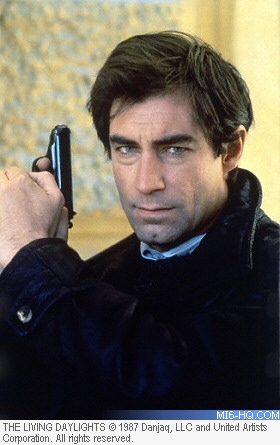
Above: Timothy Dalton lends a cool, serious composure to 007.
|
Happily, the series has revived itself to welcome Dalton. It opens with the moral dilemma that Full Metal Jacket took nearly two hours to waddle up to: whether a good soldier must kill a pretty young sniper (the unenticing Maryam d'Abo). Then it's off to Vienna, London, Tangier and Afghanistan -- the usual guided tour of In spots and hot spots, with a politically savvy cast of , adversaries. An honorable KGB boss and a duplicitous KGB agent. Afghan freedom fighters who push opium on the side. A renegade arms dealer who may remind you of General Secord's friend Edwin Wilson. And 007 in the middle, juggling global juggernauts like Ollie North, but with less piety and more smarts.
Some will miss the puckishness of the old Bond; others may wilt during an overlong sequence set in the Afghan desert, when the movie turns Ishtary. But Glen, Maibaum and Michael G. Wilson (Broccoli's stepson, who serves as co- screenwriter and co-producer) have wrapped a few nifty surprises in the security blanket of genre familiarity. The gasbag KGB agent is smuggled out of Czechoslovakia through the Trans-Siberian natural gas pipeline. A professional killer and a British guard stage the best kitchen fight since the gremlins got microwaved. The requisite ski chase sends Dalton and D'Abo bobsledding down the slopes in her cello case. Throughout, the film forfeits sniggering humor to accentuate action and character. As Bond Marketing Chief Charles J. Juroe notes, "The Living Daylights is an action-adventure film whose hero happens to be named James Bond."
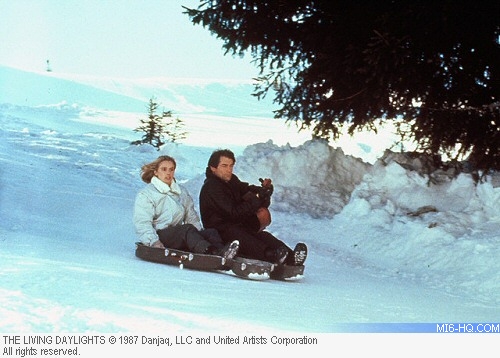
Above: Bond and his girl make an unorthodox escape from the authorities.
|
Will Dalton earn the loyalty of 007 traditionalists, while luring a new generation into Bondage? He ought to. But the only real suspense left is what to call the films when all the Fleming titles have been used up. One matter was settled long ago: Bond films have no competition as the most durable and popular series in movie history. Superman, Rocky and Jaws may have produced four installments; Friday the 13th may have hit six. But 15 films -- and more to come -- with the high gloss and safe thrills of Bond? My dear Hollywood, there are some things that just aren't done.
New York Times - 31st July 2010
It'S a tough job, keeping the world's waiters and butlers and bathing beauties apprised that he takes his martinis ''shaken, not stirred.'' But somebody has to do it, and in ''The Living Daylights'' - a great title, from a 1966 Ian Fleming short story - that somebody is Timothy Dalton. Mr. Dalton, the latest successor to the role of James Bond, is well equipped for his new responsibilities. He has enough presence, the right debonair looks and the kind of energy that the Bond series has lately been lacking. If he radiates more thoughtfulness than the role requires, maybe that's just gravy.
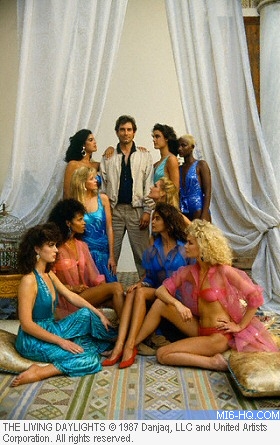
|
|
There are times, though not too many of them, when this James Bond seems to take things awfully seriously. One of the many death-defying stunts in ''The Living Daylights'' finds 007 in an airplane being piloted by Kara Milovy (Maryam d'Abo), the beautiful Czechoslovak cellist who becomes his latest flame. Kara has bungled the job, and is about to fly the plane into a mountain when Bond grabs the controls and takes over. Before saving the day, he wastes one precious moment on the kind of seething slow burn that was never part of the old James Bond personality, and is very noticeable in the new one.
Mr. Dalton, who trained at the Royal Academy of Dramatic Arts and has had a lot of experience playing Shakespeare, has a more somber, reflective acting style than the ones Bond fans have grown used to; he's less ironic than Sean Connery, less insistently suave than Roger Moore. Instead, Mr. Dalton has his own brand of charm. His Bond is world-wearier than others, but perhaps also more inclined to take the long view (as well he might, after all these years). In any case, he has enthusiasm, good looks and novelty on his side.
Left: Timothy Dalton poses for a publicity snap on location in Morocco. |
In ''The Living Daylights,'' the 16th James Bond feature, Bond becomes embroiled with a wily Soviet defector (Jeroen Krabbe), a ruthless American arms dealer (Joe Don Baker), the leader of a group of Afghan freedom fighters (Art Malik) and the head of the K.G.B. (John Rhys-Davies). The way in which all this happens is complicated but engrossing, and it takes the action from Gibraltar to Vienna to Tangier, and finally to Afghanistan. So ''The Living Daylights,'' which opens today at Loews Astor Plaza and other theaters, is appropriately scenic, and it keeps moving. But its pace can be tiring, since there are few dramatic highs or lows, merely the endless string of crises that help to keep Bond in business. Two hours and 10 minutes' worth of such crises make the film a little too long.
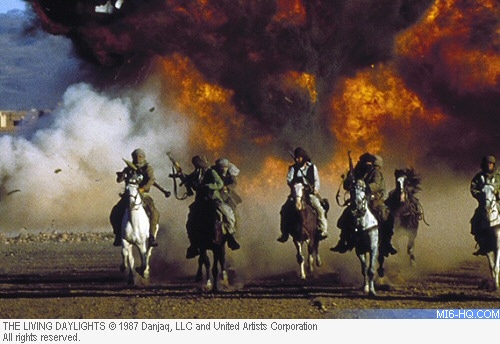
Above: 007 receives help from the Mujahideen in the climax of "The Living Daylights".
|
One major change in the formula has made 007 less of a ladies' man this time; he is even heard diplomatically telling a hotel manager that he will forgo his usual suite in favor of one with two bedrooms. The relatively chaste courtship he conducts with Kara may disappoint some fans, but making the role less compulsively lecherous also makes it a lot easier to play. Mr. Dalton, while less rakish than his predecessors, handles the romantic subplot charmingly, though Miss d'Abo greatly overdoes the naivete. It's a little disconcerting to find them clip-clopping through Vienna in a horse-drawn carriage, behaving like a couple en route to the senior prom.
Supporting characters count for a lot in Bond films, and this cast is a good one; Mr. Krabbe, as a cheerfully unprincipled turncoat, and Mr. Baker, who gets a lot of comic mileage out of the arms dealer's gung-ho boyishness, are both very enjoyable. The direction, by John Glen, has the colorful but perfunctory style that goes with the territory, and it's adequate if uninspired. At this late date, the James Bond formula doesn't require much modification. Keeping it afloat, as ''The Living Daylights'' succeeds in doing, is accomplishment enough.
Chicago Sun-Times - 31st July 1987
The raw materials of the James Bond films are so familiar by now that the series can be revived only through an injection of humor. That is, unfortunately, the one area in which the new Bond, Timothy Dalton, seems to be deficient. He's a strong actor, he holds the screen well, he's good in the serious scenes, but he never quite seems to understand that it's all a joke.
The correct tone for the Bond films was established right at the start, with Sean Connery's quizzical eyebrows and sardonic smile. He understood that the Bond character was so preposterous that only lightheartedness could save him. The moment Bond began to act like a real man in a real world, all was lost. Roger Moore understood that, too, but I'm not sure Dalton does.
Dalton is rugged, dark and saturnine, and speaks with a cool authority. We can halfway believe him in some of his scenes. And that's a problem, because the scenes are intended to be preposterous. The best Bond movies always seem to be putting us on, to be supplying the most implausible and dangerous stunts in order to assure us they can't possibly be real. But in "The Living Daylights," there is a scene where Bond and his girlfriend escape danger by sliding down a snow-covered mountain in a cello case, and damned if Dalton doesn't look as if he thinks it's just barely possible.
The plot of the new movie is the usual grab bag of recent headlines and exotic locales. Bond, who is assigned to help a renegade Russian general defect to the West, stumbles across a plot involving a crooked American arms dealer, the war in Afghanistan and a plan to smuggle a half-billion dollars worth of opium. The story takes Bond from London to Prague, from mountains to deserts, from a chase down the slopes of Gibraltar to a fight that takes place while Bond and his enemy are hanging out of an airplane. The usual stuff.
Right: (top) Timothy Dalton dons the tuxedo in a series of studio-set photoshoot pics and (below) Maryam d'Abo as the cello-playing girlfriend of General Georgi Koskov. |
|
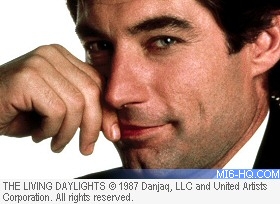
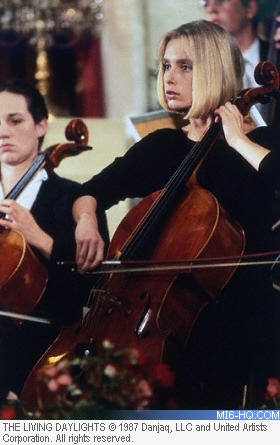
|
The key female character is Kara (Maryam d'Abo), the Russian cellist, who gets involved in the plot with the Russian general, tries to work against Bond and eventually falls in love with him. As the only "Bond girl" in the movie, d'Abo has her assignment cut out for her, and unfortunately she's not equal to it. She doesn't have the charisma or the mystique to hold the screen with Bond (or Dalton) and is the least interesting love interest in any Bond film.
There's another problem. The Bond films succeed or fail on the basis of their villains, and Joe Don Baker, as the arms-dealing Whitaker, is not one of the great Bond villains. He's a kooky phony general who plays with toy soldiers and never seems truly diabolical. Without a great Bond girl, a great villain or a hero with a sense of humor, "The Living Daylights" belongs somewhere on the lower rungs of the Bond ladder. But there are some nice stunts.
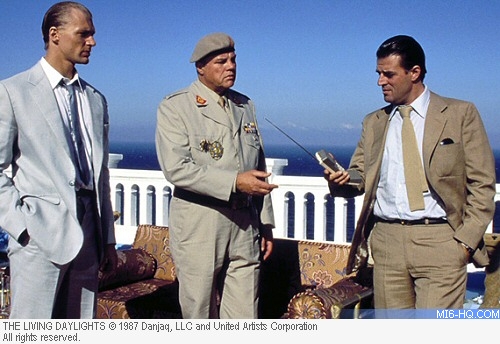
Above: "The Living Daylights" villains - Necros, Whitaker and Koskov.
|
Related Articles
 The Living Daylights
The Living Daylights